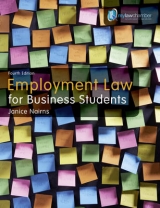
Employment Law for Business Students
Longman (Verlag)
978-1-4058-3276-2 (ISBN)
- Titel erscheint in neuer Auflage
- Artikel merken
This is the essential guide to employment law for students with no prior legal training. Employment Law for Business Students provides clear explanations of all the key topics in this area, explored through a highly practical approach. Legal rules are described as they relate to the business world, demonstrating how the law works in practice.
Chapter one
Court and tribunals, sources and institutions of employment law
1.1 Courts and tribunals
1.2 Employment Tribunals (ET)
1.3 Employment Appeal Tribunal (EAT)
1.4 Sources of employment law
1.5 How to read employment law reports and statutes
1.6 Other sources of information
1.7 Institutions of employment law
Summary checklist
Self-test questions
Further reading
Chapter two
Discrimination in employment
2.1 Anti-discrimination law
2.2 What is `discrimination'?
2.3 Sex discrimination
2.4 Racial discrimination
2.5 Victimisation
2.6 What if an employer does not intend to discriminate?
2.7 Stages at which discrimination may take place
2.8 Does an employer have any defence to a discrimination claim?
2.9 Genuine occupational qualifications
2.10 Other discriminatory acts
2.11 Are employers liable for the discriminatory actions of their employees?
2.12 Positive discrimination
2.13 European sex discrimination law
2.14 Discrimination on the grounds of pregnancy
2.15 The EOC's and the CRE's codes of practice
2.16 Sexual and racial harassment
2.17 Other harassment
2.18 Discrimination on the grounds of sexual orientation
2.19 The Immigration, Asylum and Nationality Act 2006
2.20 Disability Discrimination
2.21 Discrimination on the grounds of age, political persuasion or religion
2.22 Discrimination on the grounds of trade-union involvement
2.23 The rehabilitation of offenders
2.24 The Fixed-term Employees (Prevention of Less Favourable Treatment) Regulations
(2002) and the Part-time Workers (Prevention of Less Favourable Treatment)
Regulations (2000)
2.25 Making a discrimination claim to the Employment Tribunal
2.26 The use of equal opportunities policies
2.27 What next for discrimination law? future reform
Summary checklist
Self-test questions
Case scenarios
Further reading
Chapter three
The contract of employment
3.1 What is the contract of employment?
3.2 Why is the employment contract important?
3.3 The distinction between an employee and an independent contractor
3.4 Tests used to determine the status of the worker
3.5 Special categories of worker
3.6 Contents of the contract incorporation, express terms, implied terms and terms
implied by statute
3.7 The right to a written statement outlining the terms and conditions of employment
3.8 Restraint of trade clauses
3.9 Qualifying for employment rights continuity of employment
3.10 Changing terms of employment
3.11 Working on a Sunday
3.12 Flexible working arrangements
Summary checklist
Self-test questions
Case scenarios
Further reading
Chapter four
Equal pay, maternity and other individual employment rights
4.1 Equal pay
4.2 Equal Pay Act 1970
4.3 European law, Article 141 (formerly Article 119) and the Equal Pay Directive
4.4 EOC Code of Practice on Equal Pay (2003)
4.5 Making an equal-pay claim to the Employment Tribunal
4.6 Maternity rights
4.7 The Pregnant Workers Directive - 92/85/EC
4.8 Statutory maternity rights
4.9 The right to return to work after ordinary maternity leave or additional maternity
leave
4.10 Notification requirements as amended by the Employment Act 2002
4.11 Paternity and parental leave
4.12 Health and safety issues
4.13 Exclusions
4.14 Other individual employment rights
4.15 Data Protection
Summary checklist
Self-test questions
Case scenarios
Further reading
Chapter five
The use of disciplinary and grievance procedures
5.1 Why use disciplinary and grievance procedures?
5.2 Providing information on disciplinary and grievance procedures
5.3 The Acas code of practice: Disciplinary and Grievance Procedures (2004)
5.4 Acas handbook: Discipline at Work
5.5 Disciplinary codes and procedures
5.6 Stages involved in disciplinary procedures, investigation, counselling, informal action, disciplinary meetings and appeals
5.7 Disciplinary penalties, warnings and dismissal
5.8 Procedural fairness in unfair dismissal cases
5.9 Grievance procedures
5.10 The statutory right to be accompanied at disciplinary and grievance meetings
5.11 Statutory procedures Employment Act 2002
Summary checklist
Self-test questions
Case scenarios
Further reading
Chapter six
Termination of the employment contract
6.1 Overview of a wrongful dismissal and unfair dismissal claim
6.2 Ways in which an employment contract might be terminated
6.3 Termination of the employment contract at common law wrongful dismissal
6.4 Making a wrongful dismissal claim to a court or Employment Tribunal
6.5 Termination of the employment contract in contravention of a statute: unfair
dismissal
6.6 The effective date of termination (EDT)
6.7 Constructive dismissal
6.8 Eligibility to make an unfair dismissal claim
6.9 Reasons why a person may have been dismissed
6.10 Fairness in relation to the five potentially fair reasons
6.11 Written reasons for dismissal
6.12 The Acas arbitration scheme
6.13 Making an unfair dismissal claim to the Employment Tribunal
6.14 Remedies
Summary checklist
Self-test questions
Case scenarios
Further reading
Chapter seven
Redundancy and the transfer of undertakings
7.1 The right to a redundancy payment s 135 of the Employment Rights Act 1996
7.2 Situations which may force an employer to make employees redundant
7.3 The definition of redundancy s 139(1) of the Employment Rights Act 1996
7.4 Eligibility to make a redundancy claim
7.5 Was the employee dismissed?
7.6 The role of the employer in redundancy situations
7.7 Unfair dismissal arising from redundancy
7.8 `Bumped' redundancies
7.9 Lay-off and short-time working
7.10 Redundancy payments
7.11 What is a transfer of an undertaking?
7.12 The Transfer of Undertakings (Protection of Employment) Regulations 2006
7.13 Future developments transfer of undertakings
Summary checklist
Self-test questions
Case scenarios
Further reading
Chapter eight
Trade unions, collective bargaining and industrial action
8.1 Trade unions
8.2 Collective bargaining
8.3 Industrial action
Summary checklist
Self-test questions
Case scenarios
Further reading
ulle actions resulting from a workplace injury Sources of health and safety law
Employers' liability at common law
9.4 Breach of statutory duty
9.5 Defences to a common law or breach of statutory duty claim
9.6 Vicarious liability
9.7 Independent contractors
9.8 Statutory control the Health and Safety at Work Act 1974
9.9 General duties under the HSAWA 1974
9.10 Health and safety regulations
9.11 Other regulations
9.12 Enforcement
9.13 The Working Time Regulations 1998
Summary checklist
Self-test questions
Case scenarios
Further reading
Chapter ten
Settling disputes taking a case to the Employment Tribunal
10.1 The role of the Employment Tribunal
10.2 Administration
10.3 Composition who `judges' the case?
10.4 Jurisdiction
10.5 Funding the case
10.6 Representation
10.7 Time limits the importance of sending in the IT1 in time
10.8 Stages in tribunal procedure from the completion of form IT1 to the EAT
10.9 The applicant makes an originating application completion of form IT1
10.10 The employer responds to the application completion of the Notice of
Appearance form IT3
10.11 The role of Acas
10.12 Interlocutory stages
10.13 The tribunal hearing
10.14 The Employment Tribunal's decision
10.15 Appealing against a tribunal decision
10.16 Reform of the tribunal system
Summary checklist
Self-test questions
Further reading
| Verlagsort | Harlow |
|---|---|
| Sprache | englisch |
| Maße | 246 x 189 mm |
| Gewicht | 900 g |
| Themenwelt | Recht / Steuern ► Arbeits- / Sozialrecht ► Arbeitsrecht |
| Recht / Steuern ► EU / Internationales Recht | |
| ISBN-10 | 1-4058-3276-2 / 1405832762 |
| ISBN-13 | 978-1-4058-3276-2 / 9781405832762 |
| Zustand | Neuware |
| Haben Sie eine Frage zum Produkt? |
aus dem Bereich



